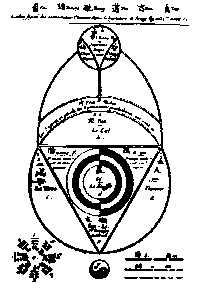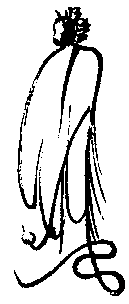
Tai Chi & Taoism
The cosmographic 'tai-chi'. 
There exists a long history of movement and exercise systems which are associated with Taoism. In some sense one can see elements of all of these as contributing to the climate from which Tai Chi emerged.
Lao Tsu, the founder of Taoism, wrote:
Yield and overcome;
Bend and be straight.-- Tao Te Ching (22)
He who stands of tiptoe is not steady.
He who strides cannot maintain the pace.-- Tao Te Ching (24)
Returning is the motion of the Tao.
Yielding is the way of the Tao.-- Tao Te Ching (40)
What is firmly established cannot be uprooted.
What is firmly grasped cannot slip away.-- Tao Te Ching (54)
Stiff and unbending is the principle of death.
Gentle and yielding is the principle of life.
Thus an Army without flexibility never wins a battle.
A tree that is unbending is easily broken.The hard and strong will fall.
The soft and weak will overcome.-- Tao Te Ching (76)
"The pure man of old slept without dreams and woke without anxiety. He ate without indulging in sweet tastes and breathed deep breaths. The pure man draws breaths from the depths of his heels, the multitude only from their throats."
And:
"[The sage] would not lean forward or backward to accomodate [things]. This is called tranquility on disturbance, (which means) that it is especially in the midst of disturbance that tranquility becomes perfect."
Talisman of the Jade Lady. 
This approach is reflected in the entire movement philosophy of Tai Chi Chuan. There is, moreover, a long tradition of Taoist monks practicing exercises. Some of these were referred to as tai-yin or Taoist Breathing. Exactly what these were and what their origins were is obscure but they are mentioned in Chinese chronicles as early as 122 B.C.
Then in the sixth century A.D. Bodihdharma (called Ta Mo in Chinese) came to the Shao-Lin Monastery and, seeing that the monks were in poor physical condition from too much meditation and too little excersize, introduced his Eighteen Form Lohan Exercise. This approach gave rise to the Wei Chia or 'outer-extrinsic' forms of exercise.
Later in the fifteenth century A.D. the purported founder of Tai Chi Chuan, the monk Chang San-feng, was honoured by the Emperor Ying- tsung with the title of chen-jen, or 'spiritual man who has attained the Tao and is no longer ruled by what he sees, hears or feels.' This indicates that already at this time there was a close association between the philosophy of Taoism and the practice of Tai Chi.
In the Ming dynasty (14th to 17th centuries), Wang Yang-ming a leading philosopher preached a philosophy which was a mixture of Taoism and Ch'an Buddhism which had certain associations with movement systems.
In any event the principles of yielding, softness, centeredness, slowness, balance, suppleness and rootedness are all elements of Taoist philosophy that Tai Chi has drawn upon in its understanding of movement, both in relation to health and also in its martial applications. One can see these influences (of softness and effortlessness) in the names of certain movements in the Tai Chi Form, such as:
- Cloud Hands
- Wind Rolls the Lotus Leaves
- Brush Dust Against the Wind
- Push the Boat with the Current
- Winds Sweeps the Plum Blossoms
- White Crane Spreads Wings
- Snake Creeps Down
- Repulse Monkey
- Embrace Tiger, Return to Mountain
- White Snake Sticks Out its Tongue
- Grasp Sparrow's Tail
- Golden Cock Sands on One Leg
- Swallow Skims the Water
- Bird Flies into Forest
- Lion Shakes it's Head
- Tiger Hugs its Head
- Wild Horse Leaps the Ravine
- White Ape Devotes Fruit
- Yellow Bee Returns to Nest
Certain features of Taoist alchemy and talismanic symbolism have also penetrated the Tai Chi forms. As part of their contemplation of nature the Taoists observed the heavens and were keen students of astronomy and astrology. Movements of the Tai Chi Form such as :
- Step Up to Seven Stars
- Embrace the Moon
- Biggest Star in the Great Dipper
- Encase the Moon in Three Rings
- The Smallest Star in the Big Dipper
- Meteor Runs After Moon
- Heavenly Steed Soars Across the Sky
Meditating Under the Protection of the Big Dipper.

Reflect this Taoist astrological concern.
Symbolism was a potent force in Taoist thinking. Taoist magic diagrams were regarded as potent talismans having great command over spiritual forces. They invoked the harmonizing influence of yin-yang and Eternal Change; the Divine Order of Heaven, Earth and Mankind; and the workings of the Universe through the principal of the Five Elements. These were symbolized by the Five Sacred Mountains (Taishan, Hengshan [Hunan], Songshan, Huashan and Hengshan [Hopei]), central places of Taoist development and pilgrimage.
Thus it is no surprise to find that the symbolism of names has, in important ways, infiltrated the forms of Tai Chi. There was a numerological component to this symbolism as well. The number '5' has a special mystical significance to Taoists (and to Chinese in general). There are the symbolic five mountains, five elements, five colours, five planets, five virtues, five emotions, five directions, etc. all of which have a mystic significance. Hence we see five Repulse Monkeys or Five Cloud Hands in the Tai Chi form. There are many instances where the numbers '1', '3', '5' and '7' figure prominently in the structure of Tai Chi.